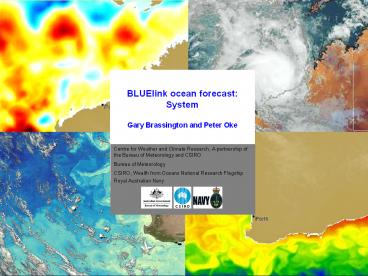BLUElink PowerPoint PPT Presentation
Title: BLUElink
1
BLUElink ocean forecast System Gary Brassington
and Peter Oke
Centre for Weather and Climate Research, A
partnership of the Bureau of Meteorology and
CSIRO Bureau of Meteorology CSIRO, Wealth from
Oceans National Research Flagship Royal
Australian Navy
2
The Bluelink System
- Data Assimilation
- BODAS
- EnOI
- 120 member ensemble
- Localised covariances
- Assimilates along-track ALTIM, coastal SLA, SST
in situ T and S
- Ocean Model
- OFAM
- MOM4p0d
- Global model
- 10 m vert res over top 200 m
3
BLUElink OceanMAPS v1.0b
System
OFAM/MOM4 - Global OGCM, eddy-resolving
Australian region BODAS - BLUElink Ocean Data
Assimilation System, EnOI Observations - Jason1,
Envisat, AMSR-E, Argo, XBT, CTD Duplicate
checker Quality control GASP - Global numerical
weather prediction fluxes Forecast
schedule Analysis (-9 days) NRT (-5 days) 7
day forecast
Real-time system
Brassington, et al, 2007 BLUElinkgt Development
of operational oceanography and servicing in
Australia, Journal of Research and Practice in
Information Technology, 39, 151-164 Oke, P. R.,
G. B. Brassington, D. A. Griffin and A. Schiller,
2008 The Bluelink ocean data assimilation system
(BODAS), Ocean Modelling, 21, 46-70 Bureau of
Meteorology Operations Bulletin
http//www.bom.gov.au/nmoc/bulletins/APOB69.pdf
Griffies, S.M., Pacanowski, R.C., Rosati, A.,
2004. A technical guide to MOM4. GFDL Ocean Group
Technical Report No. 5. NOAA/Geophysical Fluid
Dynamics Laboratory, 371 pp.
4
Recent model developments
- implicit tidal parameterisation for interior
mixing (Lee et al. 2006?) - implicit tidal parameterisation for bottom stress
- Improved topography (latest Smith/Sandwell)
- Improved surface fluxes for reanalysis
(ERA-Interim) - Higher vertical resolution near surface (5 m)
- Same horizontal grid but plans to shift to 1/10
global next year
5
Recent assimilation developments
- improved solver using a pre-conditioned
conjugate gradient - MPI-version for efficiency
- improved initialisations adaptive nudging
- exploring options for performing analyses in a
local ETKF framework
6
Intercomparisons - SST
Observations
In situ Daily file processed over 12 days GTS,
USGODAE, Coriolis Duplicate checked for superior
QC Automatic quality control
7
Intercomparisons - SST
Quality control - products
In situ Daily file processed over 12 days GTS,
USGODAE, Coriolis Duplicate checked for superior
QC Automatic quality control
Page 3 of 7 gt Contributing to QC intercomparison
8
Intercomparisons - SST
Observations operational system
Altimetry Jason1 and Envisat (2007-present) Jaso
n2 (May 2009 present) Super-obed stride 2 by 2
(2007 May 2009) Stride-obed stride 3 by 3 (May
2009 present) Window NRT (-5days to
2days) Window BRT (/- 5 days) SST AMSR-E
descending (2007 present) Super-obed stride 2
by 2 (2007 present) Window NRT/BRT (/- 1
day) NAVOCEANO AVHRR trialing MTSAT RD
9
Intercomparisons - SST
Observations
10
Intercomparisons - SST
Observations operational system
11
Intercomparisons - SST
12
Taylor diagram
Taylor diagram
R
E
Taylor, K., 2001 JGR, 106, D7, 7183-7192
13
Taylor diagram skill score
Taylor diagram
S-isolines 0.1 intervals, grey shading
Taylor, K., 2001 JGR, 106, D7, 7183-7192
14
GODAE intercomparison - TEIO
SLA
AMSRE
15
Benchmarking
16
Benchmarking
17
Intercomparisons - SST
18
Summons and Brassington
Real-time system
19
OceanMAPS - Coastal SLA
- Southern Bight region.
- Good match between de-tided obs OceanMAPS SLA
operational analysis
20
OceanMAPS - Coastal SLA
- Coastal SLA performance results vary with
location - Australian region large
- spread of latitudes
- mix of processes
- Obs relatively sparse spatially
- Ongoing analysis work.
- Details to be published.
21
Incorrect shape of front
Good validation of currents and fronts
Position of front eastward of observed
Red 2008 buoys, Blue 2007 buoys, Black
third party Lagrangian paths represent /- 4 days
of analysis date All buoys from GTS
(unprocessedand unfiltered)
22
Saddle point observed and well estimated
Poor comparison between obs and currents
EAC separation point observed further south
Tasman front observed and estimated
Generally good agreement An indication of the
ocean analysis tends to be behind real-time Good
complementary information
23
Bluelink (BOM/MOM4) model currents Sampled at
glider time/position
Glider observed 0-700m currents
Bluelink example for 15-20 Oct 07
Bluelink is quite consistent with the glider
observations, on large and small scales. It
shows vigorous eddy variability in the Solomon
Sea, masking the western boundary currents. ?
Model simulations help interpret the glider
sampling (eddy vs large-scale). ? Glider data
helps evaluate model fidelity.
William S. Kessler, PMEL
24
System evaluation obs-based fields (left) vs
model-based fields (BRAN1p5 - right)
25
System evaluation sub-surface temperature off
Eastern Aus (BRAN1p5)
26
Sensitivity to initialisation off SW WA
v2p1 Std Nudging
v1p2 Std Nudging
IAU
Observed
2/5 11/5
14/5 23/5
27
Comparisons with Argo around a big cold-core eddy
off SE Aus (BRAN1p5)
28
BRAN1.5 vs TAO ADCP zonal currents
165E
170W
147E
140W
110W
29
Where and how closely does BRAN track independent
sea-level anomalies?
- Comparisons between BRAN1.5 and with-held T/P
altimetry - ? along-track data identified for the day of each
analysis - BRAN and AVISO fields interpolated to observation
locations and times - RMS residuals and signal to noise ratios (SNR)
computed
30
(No Transcript)
31
(No Transcript)

